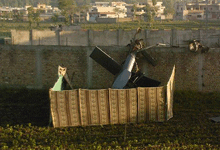When I wrote earlier this week about how quickly people around the world learned that Sohaib Athar had “live tweeted” the raid on Osama bin Laden’s compound, I thought carefully before calling him a citizen journalist.
Now Dan Mitchell has given me the opportunity to explain my thinking. In a SF Weekly post headlined “No, Twitter hasn’t replaced CNN,” Mitchell writes, “In the wake of the assassination, new-media pundits are hailing the event as another victory for social media over traditional media.”
Referring to my description of Athar as a citizen journalist, Mitchell writes, “Because he wondered on Twitter, in real time, now he’s a ‘citizen journalist.’ … Wondering on Twitter why there are helicopters flying around your neighborhood isn’t journalism.”
True, it isn’t. But Athar is not a citizen journalist simply because he wondered about something on Twitter. Rather, he’s a citizen journalist because when he came across an unusual event, he acted in a journalistic manner.
Athar is an excellent example of what we at Poynter have taken to calling the Fifth Estate: people who aren’t trained as journalists, but undertake journalistic endeavors. Some are bloggers, some run independent, hyperlocal news sites, some simply find themselves in the middle of a newsworthy event and start acting like journalists.
Here are the journalistic activities that Athar, aka @ReallyVirtual, demonstrated in his tweets during and after the raid on bin Laden’s compound.
He observed something unusual and told others about it. For example:
- “Helicopter hovering above Abbottabad at 1AM (is a rare event).”
- “A huge window shaking bang here in Abbottabad Cantt. I hope its not the start of something nasty :-S”
He answered questions from others seeking information. A Twitter user asked Athar, “@ReallyVirtual Hello sir, any update on the blasts? What has really happened?”
Athar answered: “@m0hcin all silent after the blast, but a friend heard it 6 km away too… the helicopter is gone too.”
When one person asked whether the helicopter was shot down or crashed, Athar responded: “@smedica people are saying it was not a technical fault and it was shot down. I heard it CIRCLE 3-4 times above, sounded purposeful.”
He acted as a conduit for information, sharing what he knew as he learned it. In response to another tweet, Athar tweeted, “@m0hcin the few people online at this time of the night are saying one of the copters was not Pakistani…”
Later Athar said: “The abbottabad helicopter/UFO was shot down near the Bilal Town area, and there’s report of a flash. People saying it could be a drone.”
At one point, he told people, “Here’s the location of the Abbottabad crash according to some people >>> http://on.fb.me/khjf34”
Some of what he relayed was incorrect. He acknowledged some bits were rumor; other times he noted the source:
- “Report from a taxi driver: The army has cordoned off the crash area and is conducting door-to-door search in the surrounding”
- “Another rumor: two copters that followed the crashed one were foreign Cobras – and got away”
- “Report from a sweeper: A family also died in the crash, and one of the helicopter riders got away and is now being searched for.”
He sought reports from news sources and shared them. An hour after the incident, he tweeted a link to an initial news story about a helicopter crash.
Later he tweeted a link to another report and said the crash “could actually be the training accident scenario they’re saying it was.” (The story now describes the bin Laden connection; at the time it didn’t.)
Soon after, he retweeted accounts from a local news source:
“A Major of the #Pakistan #Army’s 19 FF, Platoon CO says incident at #Abbottabad where #helicopter crashed is accidental and not an “attack”
“The Major also says no “missiles” were fired and all such exaggerated reports are nothing but rumours #Pakistan”
He traded what he had heard with others in a shared effort to figure out what was going on. When Athar said he had heard the helicopter circle three or four times, another person responded, “@ReallyVirtual 3-4 times is a little less. I’ve been hearing helicopter flying since 12.35 am may be 10-12 times!”
- A photo taken by a local resident shows the wreckage of a helicopter next to the wall of the compound where, according to officials, Osama bin Laden was shot and killed in Abbottabad, Pakistan. (Mohammad Zubair/AP)

Athar said, “@smedica It must have been more, I started noticing the helicpoter when the noise got irritating – which part of Abbottabd are you in?”
When a user tweeted that a news outlet was reporting that two Chinook helicopters had been involved, Athar told him, “@kursed Well, there were at least two copters last night, I heard one but a friend heard two, for 15-20 minutes.”
He analyzed what was happening. Professional journalists don’t simply transcribe; they try to make sense of what’s going on. So did Athar:
- “Since taliban (probably) don’t have helicpoters, and since they’re saying it was not ‘ours’, so must be a complicated situation #abbottabad”
- “@tahirakram very likely – but it was too noisy to be a spy craft, or, a very poor spy craft it was.”
At 10:45 pm ET, when Twitter was abuzz with speculation about what President Obama would say in his speech, Athar retweeted this thought from another user:
“I think the helicopter crash in Abbottabad, Pakistan and the President Obama breaking news address are connected.”
Any one of these activities may simply amount to conversation among friends. Taken together, it looks like journalism.
The difference between a witness and a citizen journalist
My previous reporting on citizen journalism has me thinking that there’s a ladder of journalistic activities, starting at the bottom with actions that are not uniquely journalistic.
Let’s start at the bottom of the ladder: witnessing something newsworthy. That alone doesn’t make you a citizen journalist.
The next level up would be sharing what you witnessed. In the past, we were limited in how we did this. No one called it citizen journalism if you told your friends about the bank robbery you saw.
But digital publishing tools like blogs, Twitter, Flickr and Ustream mean that simply by sharing something, you act as a publisher. So if you’re Janis Krums and tweet a photo of a U.S. Airways plane in the Hudson River, you’re acting both as a witness and a publisher.
Other activities move you further up the ladder: seeking corroborating evidence, interviewing people, vetting sources, confirming information before sharing it, analyzing what happened, providing context. Each one is a specialized type of journalistic activity.
Journalism in plain view
In the professional journalism model that existed until recently, the only evidence of this work was the final product. The story or news package was the tip of the iceberg above the water; everything else was below the surface.
Twitter has enabled journalists – professionals and amateurs – to do this work in plain sight. The means of newsgathering can be the means of publishing, and both types of tweets are intermingled. The tweets are journalism — simultaneously process and end product.
Some have taken to calling NPR’s Andy Carvin a one-man news agency because he has modeled this public-facing form of newsgathering and publishing: finding sources, retweeting first-person accounts, asking people how they know things, seeking confirmation and verification and adding occasional commentary.
I don’t think Sohaib Athar’s work a few nights ago is as deliberate or effective as Carvin’s. An amateur slugger probably won’t hit a home run off a major league pitcher, but they’re both playing baseball.
If Carvin’s a professional journalist, Athar is a citizen journalist. (And if you don’t think Carvin’s a journalist, then perhaps your definition of journalism relies too heavily on tools like a typewriter and a notepad, rather than activities, no matter how they’re conducted.)
What becomes of the citizen journalist after the news event has passed?
In the hours after Athar’s role was discovered, he gained about 85,000 Twitter followers. SF Weekly’s Mitchell questions whether the massive increase in Athar’s followers makes him a citizen journalist. On its own, it doesn’t. But his large following means he now has a distribution network, which he can use however he likes.
And in the days after the raid, he decided to use it to act like a journalist, posting photos of the compound and of the media covering the story.
Mitchell notes this, but questions its significance: “That is cool, but now the place is swarming with reporters with much better equipment and access to better information.”
I’m not sure that the reporters who have swarmed into Abbottabad have “better information.” Athar himself has noted how the media has misreported facts relating to his town and his tweets about the raid.
As for tools, with every passing month, more journalists are using consumer devices to do their jobs. These devices lower the cost of newsgathering and enable self-publication. Why do we celebrate this when professionals use these tools in this way and denigrate it when regular people do?
Professionals vs. amateurs
I’m starting to think that professional journalists get more caught up with the “citizen journalist” label than the citizen journalists themselves. Perhaps “citizen journalists vs. journalists” is the new “bloggers vs. journalists” debate.
Sometimes people’s glee about the power of social media and new forms of journalism looks a lot like a celebration of the decline of professional journalism. We shouldn’t extrapolate that to mean that there is a competition between emerging and longstanding forms of media, in which one side must win and the other lose. (That doesn’t mean that the professionalization of amateurs doesn’t have an impact on the people who do this work for a living.)
What Athar did was journalistic. Social media brought it to the attention of professional journalists, who wrote about what he observed. Some of these stories simply noted that he heard some of the sounds of the raid. Others focused on the changing ways that we become informed about our world. Hundreds, if not thousands, of works of journalism were created as these professionals brought the news to their audiences.
Athar added to the body of knowledge. We know more about the raid, and about how people share information, because of him. That’s a good thing. No news consumers lost out here, whether they’re CNN viewers or Athar’s followers. And no professionals did, either.







Comments